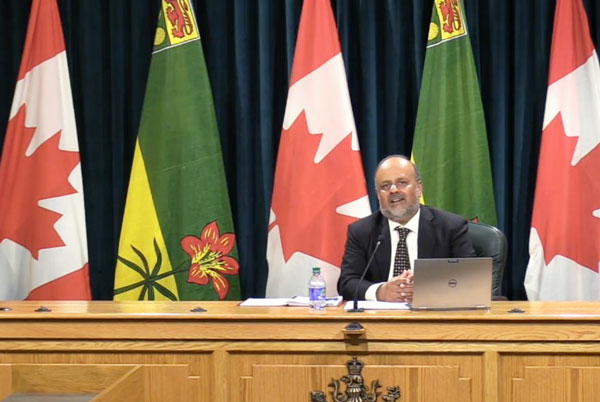
Saskatchewan’s chief medical health officer is concerned about rising COVID-19 case number. Speaking to reporters from Regina Tuesday, Dr. Saqib Shahab urged residents to take action as stabilizing the positive case rate at current levels still allows the pandemic situation in the province to remain manageable.
Eighteen people are hospitalized with COVID-19, including six in the north central zone, the province’s COVID-19 update said Tuesday.
The north central includes three sub-zones Prince Albert is the only community listed in North Central 2.
As of Tuesday, the north central zone as a whole, which includes regions north and south of the city, had 91 active cases of COVID-19. That means the north-central has the second highest number of active COVID cases behind Saskatoon with 101.
Prince Albert added four new cases Tuesday, bringing the city’s active case count total to 48. A total of 207 COVID tests were conducted in the north central zone Monday.
According to a press release issued by the province, one case previously assigned to the north central zone as determined to be out-of-province. That case was removed from the zone’s total.
Province-wide, there were 44 new cases of COVID-19 identified Monday, bringing the current active total to 427. That comes after 66 cases were reported the day prior.
Public health continues to track the source of COVID-19 spread. In Saskatoon, most of the spread seems to have originated from local nightclubs.
“Even though our case numbers may be higher than the summer, we do need to keep the numbers stable. We can’t see them rising indefinitely,” Shahab said.
He added that situations where a majority of cases can be tied back to one or more large gatherings or events indicate a high likelihood of keeping the pandemic under control, however, a large number of sporadic cases without any known connections would be a cause for concern.
In addition to the outbreak at the Prince Albert Gospel Outreach Centre, which has now led to 107 first, second and third generation positive tests in 17 communities and included over 450 people in contact tracing investigations, public health officials are tracking outbreaks linked to Saskatoon nightclubs.
“You can see how one transmission can quickly snowball into a very large impact in the province,” Shahab said.
“Not only does this pose a public health risk in a number of communities, but require a significant amount of health resources to conduct testing, contact tracing and acute care as people become severely ill.”
It’s not just older adults that need to take heed, he stressed, as current hospitalized cases involve residents as young as 30. The two individuals in the ICU, one each in Regina and Saskatoon, are in the 50-79 age range.
If the number of cases continues to rise, Shahab said restrictions could be re-introduced, either regionally or on specific sectors struggling to keep people from clustering and spreading the virus.
Shahab pointed to the spring outbreak in the far north, where stringent restrictions on gathering sizes and other activities helped bring a large outbreak under control.
He didn’t indicate any plans to bring in widespread restrictions province-wide as seen in the pandemic’s early days.
“If this continues, my preference would be we focus on those facilities that have issues with crowding and not sectors that haven’t been a problem,” Shahab said.
“If we start seeing an increase in exposures … and they start rising, you may have to consider local restrictions at that time. What we’ve seen is we get spikes in different parts of the province. They go up and come down. If we have a large number of active cases due to a defined outbreak, that is a situation we can manage.”
Shahab said, though, that while many cases can be tied to a handful of superspreader events, the province is also seeing a rise in sporadic cases without any known chains of transmission.
If Saskatchewan can stay at around 30-40 cases per day, he said, the health care system can still manage. It’s when numbers rise above that rate that issues begin to arise.
While Shahab called on residents about a month ago to re-evaluate their bubble, this time, he called on businesses to rethink the way they operate.
He said that many businesses, especially essential businesses, stayed open throughout the pandemic. They did so, he added, with special measures in place, measures everyone can learn from.
Mask use and installing plexiglass barriers when that physical distance can’t be maintained is important, Shahab said, even between employees.
“Colleagues or cohorts shouldn’t be part of your extended household bubble,” he said, adding that workers have to treat their job like they would any other public place and stay distant and wear a mask if they can’t guarantee they can stay 2 metres apart.
“We need to re look at how we operate as employees, employers and businesses. Mask use is an additional layer we are starting to use quite a bit. If we’re more consistent with that all the time, these measures could have a dramatic impact over the next two weeks.”
Shahab added that it’s up to customers as much as it is businesses to ensure they keep their distance and wear a mask when possible – even if they’re running into a retail store for a quick item. Following public health guidelines, he said, is as important as ever. It doesn’t mean you can’t go out, he said, rather, if you do go out, do so safely.
“As long as we do that, there’s a good chance that we can stabilize this,” Shahab said.
“It just means we have to focus again.”

